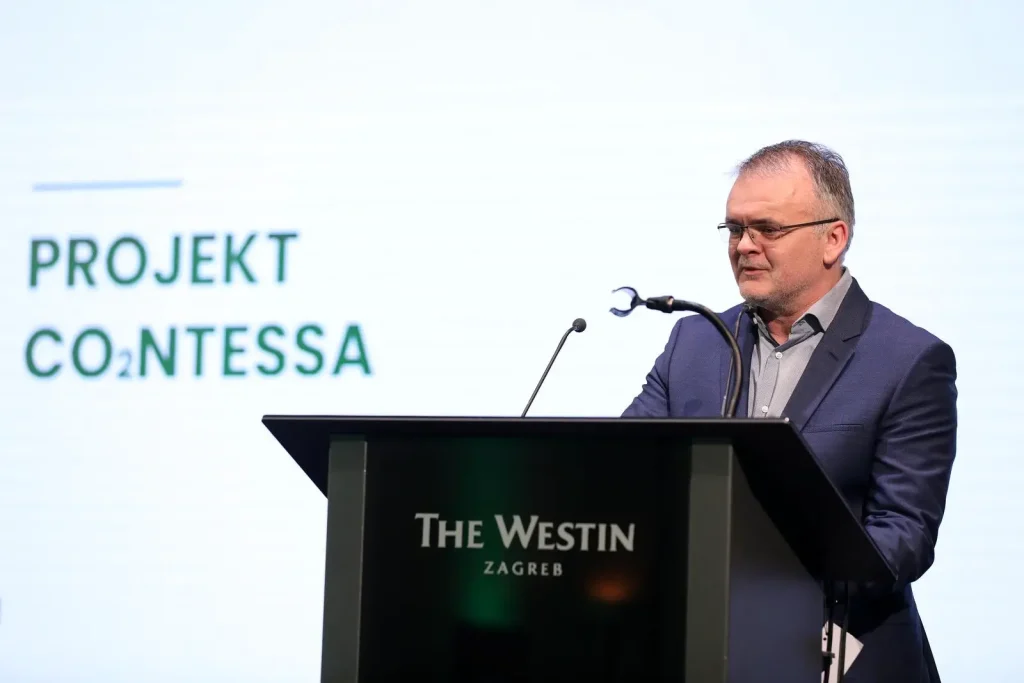As Poslovni Dnevnik/Suzana Varosanec writes, with the already agreed upon cooperation on a globally unique project called CO2NTESSA between the Croatian Nexe Group and their international partner Thyssenkrupp Group, the Nasice cement industry was the first to jump on the train to apply for a CO2 neutral cement production project to the Innovation Fund for financing large-scale projects.
With an estimated value of 400 million euros, this will be one of the largest planned industrial projects in all of Croatia, which also represents the first on-shore CO2 storage in all of Europe. Namely, the Croatian Nexe Group would become the first user of the future infrastructure for the transport and storage of carbon dioxide that the Republic of Croatia plans to implement as part of the wider Croatia GT CCS project. The warehouse where the contained CO2 will be disposed of and transported via pipelines is located nearby at the Bockovci-1 location.
There, CO2 will be placed into the reservoir, which will be a saline aquifer. In addition to that, as part of cross-border cooperation on the Croatia GT CCS project, this deposit in Slavonia will be used by the neighbouring Hungarian cement industry, a move which is expected to be realised as part of the operational activities for which Plinacro and the Hydrocarbons Agency are in charge. The project of the Croatian Nexe and the German group, which otherwise has more than 70,000 patents, envisages the construction of a new plant based on Oxyfuel technology of the second generation, which repesents the only long-term current solution for the complete removal of harmful CO2 emissions.
The contract was signed last week here in Zagreb by Ivan Ergovic, the president of the Croatian Nexe Group, the largest company within this group which is the leading regional producer of construction materials, and Frank Ruoss, a member of the Management Board of the Polysius business unit in the ThyssenKrupp Industrial Solutions group.
By the end of 2024, the plan is to close the financial structure. At the same time, in 2025, the preparation of project documentation and the obtaining of all permits are planned, while the first “shovel” to hit the ground is expected to do so in 2026, and the full functionality of the new factory is expected in the year 2029. According to the current plans, at the turn of the next decade, the Croatian Nexe Group will produce CO2 neutral cement and be price competitive, with the aim to fulfill all of the guidelines of green construction and the European Green Plan implied.
As for the closing of the financial structure, the Croatian Nexe Group is counting on the support of the banks in the remaining part of around 200 million euros.
“We have a letter of support from the Croatian Bank for Reconstruction and Development (HBOR), and a letter of support from the European Bank for Reconstruction and Development, as well as several commercial banks, such as Erste and Nova Hrvatska Banka,” Ergovic revealed.
The Croatian Nexe Group wants to be a leader in the green transition, according to Ergovic, and that is why it has been focused on the implementation of projects with the aim of reducing our carbon footprint, increasing energy efficiency and increasing the share of use of alternative fuels and raw materials for many years now.
In order to ensure the long-term development and sustainability of business, and to be more prepared for new market circumstances, at the end of last year, they defined a new Group Development Strategy for the period 2022-2030.
In the strategic pillars, the energy and green transition stand out as the main goals. The energy transition implies a series of projects aimed at reducing the energy dependence of their factories by investing in energy production from renewable sources, while the green transition implies a reduction of CO2 emissions by more than 50% by the year 2030 by investing in new technological solutions and through operational excellence.
Their cement factory in Nasice accounts for a third of all current Croatian production, with more than a million tonnes of cement made by year, and with 50 percent of it being exported. Cement production is an energy-intensive industry and one million tonnes of cement requires more than 900 GWh, with temperatures needing to be higher than 1400 degrees Celsius. This produces more than 700,000 tonnes of CO2 annually. More than 60 percent of these emissions cannot be avoided by using renewable energy sources, so this project represents an excellent solution.
Ergovic also pointed out that this is the future of the entire cement industry because this innovative technology enables the complete removal of CO2 from the production process, which would mean the removal of more than 700,000 tonnes per year. This is the amount emitted annually by more than 500,000 fossil fuel vehicles, and is the equivalent of 3 percent of the total CO2 emissions created here in the Republic of Croatia.
As Ruoss pointed out, the decarbonisation of the whole industry is one of the most important tasks of our time, and for the cement industry in particular, this means producing products in a more sustainable and carbon-neutral way in the future.
“This represents a great challenge that requires the use of new technologies. Our technology enables the optimal capture of CO2 generated in the production process, which
significantly contributes to the green transition of the cement industry,” concluded Ruoss.
For more, check out our dedicated business section.









